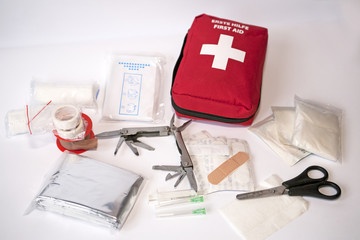When preparing for your next adventure, don't forget to pack a well-stocked first aid kit. Whether you're embarking on a hiking expedition, a beach vacation, or a city tour, accidents and minor injuries can happen anywhere. Having the right supplies on hand can make all the difference in addressing injuries promptly and effectively. Here's a guide to essential first aid supplies to include in your travel kit:
-
Bandages and Adhesive Tape: Various sizes of adhesive bandages (band-aids) are essential for covering minor cuts and scrapes. Additionally, include adhesive tape for securing bandages or creating makeshift splints.
-
Sterile Gauze Pads and Roll: Sterile gauze pads are ideal for cleaning and covering larger wounds. A gauze roll can be used to secure dressings or to wrap sprains and strains.
-
Antiseptic Wipes or Solution: Antiseptic wipes or a small bottle of antiseptic solution are crucial for cleaning wounds and preventing infection.
-
Antibacterial Ointment: Include a tube of antibacterial ointment such as Bacitracin or Neosporin to apply to cuts and scrapes after cleaning.
-
Pain Relievers: Pack over-the-counter pain relievers like ibuprofen or acetaminophen to alleviate minor aches and pains, as well as reduce fever.
-
Antihistamines: Antihistamines such as Benadryl can provide relief from allergic reactions, insect bites, and minor allergic symptoms like itching and hives.
-
Tweezers and Scissors: Tweezers are handy for removing splinters, ticks, and other foreign objects from the skin. Scissors can be used to cut gauze, adhesive tape, or clothing in emergencies.
-
Thermometer: A compact digital thermometer allows you to monitor your temperature and detect fever, especially important when traveling with children.
-
Medical Gloves: Disposable medical gloves provide protection when attending to someone else's injury or when dealing with bodily fluids.
-
Emergency Contact Information: Keep a list of emergency contact numbers, including local emergency services and your personal physician, in your first aid kit.
-
Personal Medications: If you take prescription medications, be sure to pack an ample supply for the duration of your trip, along with a copy of your prescription.
-
Medical Information Card: Include a card with essential medical information such as allergies, blood type, and any chronic conditions you may have.
-
Compact First Aid Manual: A small first aid manual or reference guide can provide helpful instructions on managing various injuries and medical emergencies.
-
Additional Supplies: Depending on your destination and activities, consider packing additional items such as blister pads, eye drops, oral rehydration salts, and sunscreen.
Remember to periodically check and replenish your first aid kit, replacing any items that have expired or been used. Keep your kit in a durable, waterproof container that is easily accessible during your travels. Having a well-equipped first aid kit gives you peace of mind knowing that you're prepared to handle minor health issues while enjoying your trip to the fullest. Safe travels!


No comments yet